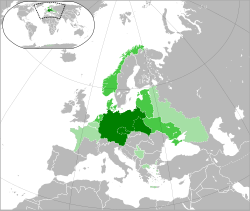
Back أوروبا تحت الاحتلال الألماني Arabic Europa ocupada per Alemanya Catalan داگیرکاریی ئەڵمانیا لە ئەورووپا CKB Γερμανοκρατούμενη Ευρώπη Greek Europa ocupada por la Alemania nazi Spanish اروپای تحت اشغال آلمان نازی Persian Europe sous domination nazie French שטח הכיבוש הנאצי HE Pendudukan Jerman di Eropa ID Europa occupata dai tedeschi Italian
German-occupied Europe | |||||||
|---|---|---|---|---|---|---|---|
| 1938–1945 | |||||||
| Anthem: 1938–1945 "Das Lied der Deutschen" "The song of the Germans" | |||||||
Europe at the height of German expansion in 1942:
| |||||||
| Capital | Berlin | ||||||
| Common languages | German | ||||||
| Demonym(s) | German | ||||||
| Reich Commissioner | |||||||
• 1938–1945 | Fritz Katzmann | ||||||
| Reichsstatthalter | |||||||
• 1938–1945 | Adolf Eichmann | ||||||
• 1940–1945 | Heinrich Himmler | ||||||
• 1941–1945 | Hermann Göring | ||||||
| Historical era | Interwar period | ||||||
| Area | |||||||
| 1942 | 3,300,000[1] km2 (1,300,000 sq mi) | ||||||
| Population | |||||||
• 1942 | 238,000,000[1] | ||||||
| Currency | Reichsmark (ℛℳ) | ||||||
| |||||||
German-occupied Europe (or Nazi-occupied Europe) refers to the sovereign countries of Europe which were wholly or partly militarily occupied and civil-occupied, including puppet governments, by the military forces and the government of Nazi Germany at various times between 1939 and 1945, during World War II, administered by the Nazi regime under the dictatorship of Adolf Hitler.[2]
The German Wehrmacht occupied European territory:
- as far east as the town of Mozdok in the North Caucasus in the Soviet Union (1942–1943)
- as far north as the settlement of Barentsburg in Svalbard in the Kingdom of Norway
- as far south as the island of Gavdos in the Kingdom of Greece
- as far west as the island of Ushant in the French Republic
In 1941, around 280 million people in Europe, more than half the population, were governed by Germany or their allies and puppet states.[citation needed]
Outside of Europe, German forces controlled areas of North Africa, including Egypt, Libya, and Tunisia between 1940 and 1945. German military scientists established the Schatzgraber Weather Station as far north as Alexandra Land in Francis Joseph Land. Manned German weather stations also operated in North America included three in Greenland, Holzauge, Bassgeiger, and Edelweiss. German Kriegsmarine ships also operated in all oceans of the world throughout World War II.
Cite error: There are <ref group=lower-alpha> tags or {{efn}} templates on this page, but the references will not show without a {{reflist|group=lower-alpha}} template or {{notelist}} template (see the help page).
- ^ a b Berend, Iván T. (2016). An Economic History of Twentieth-Century Europe: Economic Regimes from Laissez-Faire to Globalization. Cambridge University Press. p. 72. ISBN 9781107136427.
- ^ Encyclopædia Britannica, German occupied Europe. World War II. Retrieved 1 September 2015 from the Internet Archive.



